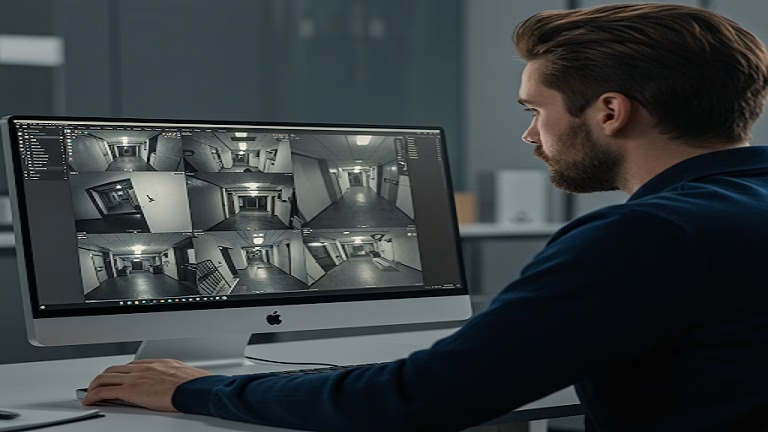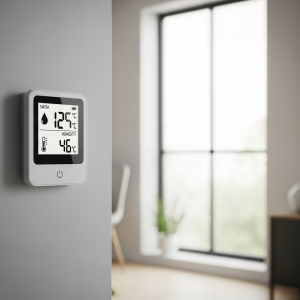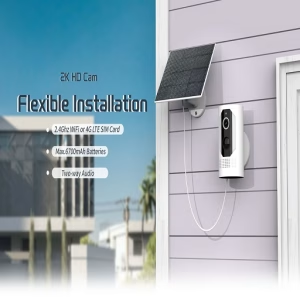 Choosing the Right Wireless Security Camera for Business: A Comprehensive Guide
Choosing the Right Wireless Security Camera for Business: A Comprehensive Guide
Protect your business with Wireless Security Camera for Business. This guide simplifies choosing the right system for your needs, covering installation, flexibility & advanced features. Secure your assets & employees effectively.
Understanding the Advantages of Wireless Security Cameras for Business:
Before diving into the selection process, it’s crucial to appreciate the distinct advantages that wireless security cameras bring to the table:
Simplified Installation:
One of the most significant benefits is the ease of installation. Unlike wired systems that require running extensive cables for power and data transmission, wireless cameras primarily need a power source and connection to your Wi-Fi network. This significantly reduces installation time, labor costs, and disruption to your business operations.
Enhanced Flexibility and Scalability:
Wireless cameras offer unparalleled flexibility in placement. You can easily position them in optimal locations without being constrained by cable runs. Moreover, scaling your security system is a breeze. Adding or relocating cameras as your business grows or your needs change is a straightforward process.
Reduced Infrastructure Costs:
By eliminating the need for extensive cabling infrastructure, wireless systems can lead to significant cost savings in the long run. You won’t need to invest in miles of cable, conduit, or the labor associated with their installation.
Discreet and Aesthetically Pleasing:
Wireless cameras often boast a more discreet design compared to bulky wired cameras and their associated cabling. This can be particularly beneficial for businesses where aesthetics are a concern, such as retail stores or customer-facing environments.
Advanced Features and Integration:
Many modern wireless security cameras come equipped with cutting-edge features like high-definition video, night vision, motion detection with smart alerts, two-way audio, and integration with smart home or business platforms.
Key Factors to Consider When Choosing a Wireless Security Camera System:
Now, let’s delve into the critical factors you need to evaluate to select the ideal wireless security camera system for your business:
1. Defining Your Security Needs and Coverage Area:
The first step is to clearly define your specific security objectives and identify the areas you need to monitor. Consider the following:
- Vulnerable Areas: Identify high-risk areas such as entry and exit points, cash registers, storage rooms, loading docks, and areas with valuable assets.
- Internal vs. External Monitoring: Determine whether you need cameras for indoor surveillance, outdoor surveillance, or both. Outdoor cameras will require weatherproof and more robust designs.
- Desired Level of Detail: Consider the level of detail you need to capture. For general monitoring, 1080p might suffice, but for identifying faces or license plates, higher resolutions like 2K or 4K might be necessary.
- Blind Spots: Analyze your premises to identify any potential blind spots where security vulnerabilities might exist.
- Future Needs: Anticipate any future expansion or changes in your business that might require adjustments to your security system.
2. Understanding Image Quality and Resolution:
The clarity and detail of the video footage are crucial for effective surveillance. Consider the following resolutions:
- 720p (HD): Offers decent image quality for general monitoring but might lack detail for identification purposes.
- 1080p (Full HD): A widely adopted standard that provides good clarity and detail for most business applications.
- 2K (QHD): Offers significantly more detail than 1080p, improving the ability to identify faces and objects.
- 4K (Ultra HD): Provides the highest level of detail, ideal for situations where precise identification is critical.
3. Evaluating Night Vision Capabilities:
Round-the-clock surveillance is essential for most businesses. Consider the following night vision technologies:
- Infrared (IR) Night Vision: Uses infrared LEDs to illuminate the scene in black and white. The range and clarity of IR night vision vary depending on the camera.
- Color Night Vision: Utilizes starlight sensors or ambient light to capture color footage even in low-light conditions, providing more detailed information.
4. Assessing Motion Detection and Alert Systems:
Motion detection is a fundamental feature that triggers recording and sends alerts when activity is detected. Consider the following:
- Customizable Motion Detection Zones: Allows you to define specific areas within the camera’s field of view where motion detection is active, reducing false alarms from irrelevant movements.
- Adjustable Sensitivity Levels: Enables you to fine-tune the sensitivity of the motion detection to minimize false triggers from minor movements.
- Smart Alerts: Advanced systems offer intelligent alerts that can distinguish between people, vehicles, and other objects, providing more relevant notifications.
5. Considering Two-Way Audio Functionality:
Two-way audio can be a valuable feature for various business applications, such as:
- Remote Communication with Visitors or Delivery Personnel: Allows you to interact with individuals at your premises remotely.
- Deterring Intruders: The ability to speak through the camera can act as a deterrent to potential intruders.
- Monitoring Employee Interactions: Can be used (within legal and ethical boundaries) to monitor interactions in customer service areas.
6. Analyzing Field of View and Pan-Tilt-Zoom (PTZ) Capabilities:
The field of view (FOV) determines the area the camera can capture. Consider:
- Wide-Angle Lenses: Cover a broader area, reducing the number of cameras needed for comprehensive coverage.
- Pan-Tilt-Zoom (PTZ) Cameras: Offer the ability to remotely pan horizontally, tilt vertically, and zoom in on specific areas, providing dynamic surveillance of large spaces.
7. Understanding Wireless Connectivity and Range:
The reliability and range of the wireless connection are crucial for seamless operation. Consider:
- Wi-Fi Standards: Ensure the cameras support the Wi-Fi standards compatible with your network (e.g., 802.11n, 802.11ac).
- Wireless Range: Assess the distance between the cameras and your Wi-Fi router, considering potential obstacles that might interfere with the signal. Mesh Wi-Fi systems or Wi-Fi extenders can help improve coverage in larger premises.
- Dual-Band Wi-Fi: Cameras that support both 2.4 GHz and 5 GHz bands offer more flexibility and can potentially reduce interference.
8. Evaluating Local and Cloud Storage Options:
Decide how you want to store your recorded footage:
- Local Storage (SD Card or NVR): Offers direct storage on a memory card within the camera or a dedicated Network Video Recorder (NVR) on your premises. This provides more control over your data but requires physical security for the storage devices.
- Cloud Storage: Stores footage securely on the provider’s servers, offering remote access and data redundancy. Cloud storage plans typically come with subscription fees.
- Hybrid Storage: Some systems offer a combination of local and cloud storage for redundancy and flexibility.
9. Assessing Ease of Use and Mobile App Functionality:
A user-friendly interface and a robust mobile app are essential for managing your security system effectively. Consider:
- Intuitive Setup Process: The initial setup should be straightforward and easy to follow.
- User-Friendly Mobile App: The app should allow for easy viewing of live feeds, accessing recordings, receiving notifications, and managing camera settings.
- Remote Management Capabilities: The system should allow for remote configuration and troubleshooting.
10. Considering Weather Resistance for Outdoor Cameras:
If you need outdoor surveillance, ensure the cameras are specifically designed for outdoor use and have a sufficient IP (Ingress Protection) rating to withstand various weather conditions like rain, snow, and dust.
11. Evaluating Power Options:
Consider how the cameras will be powered:
- AC Power: Traditional power adapters that plug into standard outlets.
- Battery Power: Offers more flexibility in placement but requires periodic charging or battery replacement.
- Power over Ethernet (PoE): Allows both power and data to be transmitted over a single Ethernet cable, simplifying installation for cameras near Ethernet ports.
12. Exploring Integration Capabilities:
Consider if you want your security system to integrate with other business systems or smart platforms, such as:
- Access Control Systems: Integrating with door locks or key card systems can provide a unified security solution.
- Smart Home/Business Platforms: Integration with platforms like Amazon Alexa or Google Assistant can enable voice control and automation.
13. Understanding Privacy Considerations:
It’s crucial to be aware of and comply with all relevant privacy regulations regarding video surveillance. Inform your employees and customers about the presence of security cameras and ensure you are using the footage responsibly and ethically.
Choosing the Right Brand and System:
Once you have a clear understanding of your needs and the key factors to consider, you can start exploring different brands and systems. Some popular and reputable brands in the wireless security camera market for businesses (as of late 2024/early 2025) include:
- ChenAnIoT: Known for comprehensive systems with advanced features and often suitable for various business sizes.
- Arlo: Offers user-friendly, DIY-focused systems with good image quality and smart features, suitable for small businesses.
- Ring: Provides customizable systems and integrates well with other Ring and Amazon devices.
Tips for Making the Final Decision:
- Read Reviews and Testimonials: Research user reviews and testimonials to get insights into the real-world performance and reliability of different systems.
- Compare Features and Pricing: Create a comparison chart of the features and pricing of different systems that meet your basic requirements.
- Consider Long-Term Costs: Factor in potential subscription fees for cloud storage or advanced features.
- Check Warranty and Support: Ensure the manufacturer offers a reasonable warranty and reliable customer support.
- Consider Professional Installation (If Needed): For larger or more complex installations, consider hiring professional security installers.
Conclusion:
Choosing the right wireless security camera system for your business is a significant investment that can provide invaluable protection and peace of mind. By carefully considering your specific needs, evaluating the key features discussed in this guide, and researching different brands and systems, you can make an informed decision and select a solution that effectively safeguards your assets, employees, and overall business operations in the evolving security landscape. Remember that the “best” system is the one that best aligns with your unique requirements and budget, providing reliable and comprehensive surveillance for your business.





